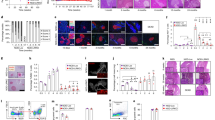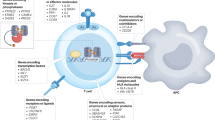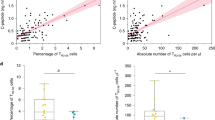Abstract
A variety of therapeutic strategies have been developed to tolerize autoreactive T cells and prevent autoimmune pathology. In terms of type 1 diabetes, prevention strategies can inhibit the priming and expansion of autoreactive T cells; however, a cure for diabetes would require tolerance to be established in the presence of primed effector cells together with replacement of the destroyed β cell mass. Replacement of β cells could be accomplished by transplantation of islets or stem cells or through islet regeneration. We will focus here on tolerogenic strategies that have been used to prevent onset of type 1 diabetes and discuss the potential for a cure.
This is a preview of subscription content, access via your institution
Access options
Subscribe to this journal
Receive 12 print issues and online access
$209.00 per year
only $17.42 per issue
Buy this article
- Purchase on Springer Link
- Instant access to full article PDF
Prices may be subject to local taxes which are calculated during checkout



Similar content being viewed by others
References
Egwuagu, C. E., Charukamnoetkanok, P. & Gery, I. Thymic expression of autoantigens correlates with resistance to autoimmune disease. J. Immunol. 159, 3109–3131 (1997).
Hanahan, D. Peripheral-antigen-expressing cells in thymic medulla: factors in self-tolerance and autoimmunity. Curr. Opin. Immunol. 10, 656–662 (1998).
Parish, N. M., Rayner, D., Cooke, A. & Roitt, I. M. An investigation of the nature of induced suppression to experimental autoimmune thyroiditis. Immunology 63, 199–203 (1988).
Bitar, D. M. & Whitacre, C. C. Suppression of experimental autoimmune encephalomyelitis by the oral administration of myelin basic protein. Cell. Immunol. 112, 364–370 (1988).
Heeger, P. S. et al. Revisiting tolerance induced by autoantigen in incomplete Freund's adjuvant. J. Immunol. 164, 5771–5781 (2000).
al-Sabbagh, A., Miller, A., Santos, L. M. & Weiner, H. L. Antigen-driven tissue-specific suppression following oral tolerance: orally administered myelin basic protein suppresses proteolipid protein- induced experimental autoimmune encephalomyelitis in the SJL mouse. Eur. J. Immunol. 24, 2104–2109 (1994).
Metzler, B. W. & Wraith, D.C. Inhibition of experimental autoimmune encephalomyelitis by inhalation but not oral administration of the encephalitogenic peptide: influence of MHC binding affinity. Int. Immunol. 5, 1159–1165 (1993).
Burrows, G. G. et al. Regulation of encephalitogenic T cells with recombinant TCR ligands. J. Immunol. 164, 6366–6371 (2000).
Salomon, B. & Bluestone, J. A. Complexities of CD28/B7: CTLA-4 costimulatory pathways in autoimmunity and transplantation. Annu. Rev. Immunol. 19, 225–252 (2001).
Kataoka, S. et al. Immunologic aspects of the nonobese diabetic (NOD) mouse. Abnormalities of cellular immunity. Diabetes 32, 247–253 (1983).
Nakhooda, A. F., Like, A. A., Chappel, C. I., Wei, C. N. & Marliss, E. B. The spontaneously diabetic Wistar rat (the “BB” rat). Studies prior to and during development of the overt syndrome. Diabetologia 14, 199–207 (1978).
Todd, J. A. Genetics of type 1 diabetes. Pathol. Biol. Paris 45, 219–227 (1997).
O'Reilly, L. A. et al. Characterization of pancreatic islet cell infiltrates in NOD mice: effect of cell transfer and transgene expression. Eur. J. Immunol. 21, 1171–1180 (1991).
Miyazaki, A. et al. Predominance of T lymphocytes in pancreatic islets and spleen of pre- diabetic non-obese diabetic (NOD) mice: a longitudinal study. Clin. Exp. Immunol. 60, 622–630 (1985).
Sibley, R. K., Sutherland, D. E., Goetz, F. & Michael, A. F. Recurrent diabetes mellitus in the pancreas iso- and allograft. A light and electron microscopic and immunohistochemical analysis of four cases. Lab. Invest. 53, 132–144 (1985).
Campbell, I. L., Wong, G. H., Schrader, J. W. & Harrison, L. C. Interferon-γ enhances the expression of the major histocompatibility class I antigens on mouse pancreatic β cells. Diabetes 34, 1205–1209 (1985).
Yang, X. D. et al. Effect of tumor necrosis factor α on insulin-dependent diabetes mellitus in NOD mice. 1. The early development of autoimmunity and the diabetogenic process. J. Exp. Med. 180, 995–1004 (1994).
Mandrup-Poulsen, T. et al. Islet cytotoxicity of interleukin 1. Influence of culture conditions and islet donor characteristics. Diabetes 36, 641–647 (1987).
Corbett, J. A., Sweetland, M. A., Lancaster, J. R. Jr & McDaniel, M. L. A 1-hour pulse with IL-1 β induces formation of nitric oxide and inhibits insulin secretion by rat islets of Langerhans: evidence for a tyrosine kinase signaling mechanism. FASEB J. 7, 369–374 (1993).
Hutchings, P. & Cooke, A. Protection from insulin dependent diabetes mellitus afforded by insulin antigens in incomplete Freund's adjuvant depends on route of administration. J. Autoimmun. 11, 127–130 (1998).
Tisch, R., Wang, B. & Serreze, D. V. Induction of glutamic acid decarboxylase 65-specific Th2 cells and suppression of autoimmune diabetes at late stages of disease is epitope dependent. J. Immunol. 163, 1178–1187 (1999).
Tian, J. et al. Modulating autoimmune responses to GAD inhibits disease progression and prolongs islet graft survival in diabetes-prone mice. Nature Med. 2, 1348–1353 (1996).
Daniel, D. & Wegmann, D. R. Protection of nonobese diabetic mice from diabetes by intranasal or subcutaneous administration of insulin peptide B-(9-23). Proc. Natl Acad. Sci. USA 93, 956–960 (1996).
Atkinson, M. A., Maclaren, N. K. & Luchetta, R. Insulitis and diabetes in NOD mice reduced by prophylactic insulin therapy. Diabetes 39, 933–937 (1990).
Tian, J. et al. Nasal administration of glutamate decarboxylase (GAD65) peptides induces Th2 responses and prevents murine insulin-dependent diabetes. J. Exp. Med. 183, 1561–1567 (1996).
Homann, D. et al. Autoreactive CD4+ T cells protect from autoimmune diabetes via bystander suppression using the IL-4/Stat6 pathway. Immunity 11, 463–472 (1999).
Ehl, S. et al. Viral and bacterial infections interfere with peripheral tolerance induction and activate CD8+ T cells to cause immunopathology. J. Exp. Med. 187, 763-774 (1998).
Maki, T., Ichikawa, T., Blanco, R. & Porter, J. Long-term abrogation of autoimmune diabetes in nonobese diabetic mice by immunotherapy with anti-lymphocyte serum. Proc. Natl Acad. Sci. USA 89, 3434–3438 (1992).
Hutchings, P., O'Reilly, L., Parish, N. M., Waldmann, H. & Cooke, A. The use of a non-depleting anti-CD4 monoclonal antibody to re-establish tolerance to β cells in NOD mice. Eur. J. Immunol. 22, 1913–1918 (1992).
Wang, B., Gonzalez, A., Benoist, C. & Mathis, D. The role of CD8+ T cells in the initiation of insulin-dependent diabetes mellitus. Eur. J. Immunol. 26, 1762–1769 (1996).
Parish, N. M., Bowie, L., Zusman Harach, S., Phillips, J. M. & Cooke, A. Thymus-dependent monoclonal antibody-induced protection from transferred diabetes. Eur. J. Immunol. 28, 4362–4373 (1998).
Chatenoud, L., Thervet, E., Primo, J. & Bach, J. F. Anti-CD3 antibody induces long-term remission of overt autoimmunity in nonobese diabetic mice. Proc. Natl Acad. Sci. USA 91, 123–127 (1994).
Boitard, C. et al. In vivo prevention of thyroid and pancreatic autoimmunity in the BB rat by antibody to class II major histocompatibility complex gene products. Proc. Natl Acad. Sci. USA 82, 6627–6631 (1985).
Sempe, P. et al. Anti-α/β T cell receptor monoclonal antibody provides an efficient therapy for autoimmune diabetes in nonobese diabetic (NOD) mice. Eur. J. Immunol. 21, 1163–1169 (1991).
Taki, T. et al. Prevention of cyclophosphamide-induced and spontaneous diabetes in NOD/Shi/Kbe mice by anti-MHC class I Kd monoclonal antibody. Diabetes 40, 1203–1209 (1991).
Kuttler, B., Rosing, K., Lehmann, M., Brock, J. & Hahn, H. J. Prevention of autoimmune but not allogeneic destruction of grafted islets by different therapeutic strategies. J. Mol. Med. 77, 226–229 (1999).
Arreaza, G. A. et al. Neonatal activation of CD28 signaling overcomes T cell anergy and prevents autoimmune diabetes by an IL-4-dependent mechanism. J. Clin. Invest. 100, 2243–2253 (1997).
Molano, R. D. et al. Prolonged islet graft survival in NOD mice by blockade of the CD40- CD154 pathway of T-cell costimulation. Diabetes 50, 270–276 (2001).
Phillips, J. M. et al. Nondepleting anti-CD4 has an immediate action on diabetogenic effector cells, halting their destruction of pancreatic β cells. J. Immunol. 165, 1949–1955 (2000).
Hutchings, P. et al. The regulation of autoimmunity through CD4+ T cells. Autoimmunity 15, 21–23 (1993).
Qin, S. et al. “Infectious” transplantation tolerance. Science 259, 974–977 (1993).
Cobbold, S. & Waldmann, H. Infectious tolerance. Curr. Opin. Immunol. 10, 518–524 (1998).
Guo, Z. et al. Immunotherapy with nondepleting anti-CD4 monoclonal antibodies but not CD28 antagonists protects islet graft in spontaneously diabetic nod mice from autoimmune destruction and allogeneic and xenogeneic graft rejection. Transplantation 71, 1656–1665 (2001).
Chatenoud, L., Primo, J. & Bach, J. F. CD3 antibody-induced dominant self tolerance in overtly diabetic NOD mice. J. Immunol. 158, 2947–2954 (1997).
Chatenoud, L. et al. In vivo cell activation following OKT3 administration. Systemic cytokine release and modulation by corticosteroids. Transplantation 49, 697–702 (1990).
Woodle, E. S. et al. Phase I trial of a humanized, Fc receptor nonbinding OKT3 antibody, huOKT3γ1(Ala-Ala) in the treatment of acute renal allograft rejection. Transplantation 68, 608–616 (1999).
Friend, P. J. et al. Phase I study of an engineered aglycosylated humanized CD3 antibody in renal transplant rejection. Transplantation 68, 1632–1637 (1999).
Feldmann, M. & Maini, R. N. Anti-TNF-α therapy of rheumatoid arthritis: what have we learned? Annu. Rev. Immunol. 19, 163–196 (2001).
Harada, M., Kishimoto, Y. & Makino, S. Prevention of overt diabetes and insulitis in NOD mice by a single BCG vaccination. Diab. Res. Clin. Pract. 8, 85–89 (1990).
Martins, T. C. & Aguas, A. P. Mechanisms of Mycobacterium avium-induced resistance against insulin- dependent diabetes mellitus (IDDM) in non-obese diabetic (NOD) mice: role of Fas and Th1 cells. Clin. Exp. Immunol. 115, 248–254 (1999).
Elias, D. et al. Vaccination against autoimmune mouse diabetes with a T-cell epitope of the human 65-kDa heat shock protein. Proc. Natl Acad. Sci. USA 88, 3088–3091 (1991).
Quintana, F. J., Rotem, A., Carmi, P. & Cohen, I. R. Vaccination with empty plasmid DNA or CpG oligonucleotide inhibits diabetes in nonobese diabetic mice: modulation of spontaneous 60-kDa heat shock protein autoimmunity. J. Immunol. 165, 6148–6155 (2000).
Ohashi, K., Burkart, V., Flohe, S. & Kolb, H. Cutting edge: heat shock protein 60 is a putative endogenous ligand of the toll-like receptor-4 complex. J. Immunol. 164, 558–561 (2000).
Vabulas, R. M. et al. Endocytosed heat shock protein 60s use TLR2 and TLR4 to activate the toll/interleukin-1 receptor signaling pathway in innate immune cells. J. Biol. Chem. Published online 11 June 2001 as 10.1074/jbc.M103217200.
Cooke, A. et al. Infection with Schistosoma mansoni prevents insulin dependent diabetes mellitus in non-obese diabetic mice. Parasite Immunol. 21, 169–176 (1999).
Banting, F. G. B. & Best, C. H. The internal secretion of the pancreas. J. Lab. Clin. Med. 7, 465–480 (1922).
Shapiro, A. M. et al. Islet transplantation in seven patients with type 1 diabetes mellitus using a glucocorticoid-free immunosuppressive regimen. N. Engl. J. Med. 343, 230–238 (2000).
Soria, B., Skoudy, A. & Martin, F. From stem cells to β cells: new strategies in cell therapy of diabetes mellitus. Diabetologia 44, 407–415 (2001).
Pictet, R. L. & Rutter, W. J. in Handbook of Physiology (eds. Steiner, D. & Freinkel, N.) 25–66 (Williams and Wilkins, Baltimore, MD, 1972).
Weir, G. C. & Bonner-Weir, S. Islets of Langerhans: the puzzle of intraislet interactions and their relevance to diabetes. J. Clin. Invest. 85, 983–987 (1990).
Gu, D. & Sarvetnick, N. Epithelial cell proliferation and islet neogenesis in IFN-γ transgenic mice. Development 118, 33–46 (1993).
Ramiya, V. K. et al. Reversal of insulin-dependent diabetes using islets generated in vitro from pancreatic stem cells. Nature Med. 6, 278–282 (2000).
Bonner–Weir, S. et al. In vitro cultivation of human islets from expanded ductal tissue. Proc. Natl Acad. Sci. USA 97, 7999–8004 (2000).
O'Reilly, L. A. et al. α-Cell neogenesis in an animal model of IDDM. Diabetes 46, 599–606 (1997).
Jonsson, J., Carlsson, L., Edlund, T. & Edlund, H. Insulin-promoter-factor 1 is required for pancreas development in mice. Nature 371, 606–609 (1994).
Acknowledgements
We thank A. Foulis, L. O'Reilly, D. Dunne and P. Zaccone for allowing us to mention some of our unpublished collaborative results and R. Allen, M. Drage and Z. Fehervari for careful reading of the manuscript and helpful suggestions.
Author information
Authors and Affiliations
Rights and permissions
About this article
Cite this article
Cooke, A., Phillips, J. & Parish, N. Tolerogenic strategies to halt or prevent type 1 diabetes. Nat Immunol 2, 810–815 (2001). https://doi.org/10.1038/ni0901-810
Issue Date:
DOI: https://doi.org/10.1038/ni0901-810
This article is cited by
-
Immunomodulatory strategies prevent the development of autoimmune emphysema
Respiratory Research (2010)
-
Parameters influencing antigen-specific immunotherapy for Type 1 diabetes
Immunologic Research (2008)
-
Parameters influencing antigen-specific immunotherapy for type 1 diabetes
Immunologic Research (2008)



